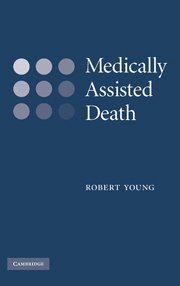Book contents
- Frontmatter
- Contents
- Acknowledgments
- 1 Introduction
- 2 A case for the legalisation of voluntary medically assisted death
- 3 Medical futility
- 4 Physician-assisted suicide
- 5 The sanctity of human life
- 6 Killing versus letting die, the doctrine of double effect, and palliative care for the dying
- 7 Professional integrity and voluntary medically assisted death
- 8 Competence and end-of-life decision making
- 9 Advance directives
- 10 Voluntary medically assisted death and slippery slope arguments
- 11 Non-voluntary euthanasia
- 12 Concluding remarks
- References
- Index of English-language legal cases
- Index of names and subjects
2 - A case for the legalisation of voluntary medically assisted death
Published online by Cambridge University Press: 05 June 2012
- Frontmatter
- Contents
- Acknowledgments
- 1 Introduction
- 2 A case for the legalisation of voluntary medically assisted death
- 3 Medical futility
- 4 Physician-assisted suicide
- 5 The sanctity of human life
- 6 Killing versus letting die, the doctrine of double effect, and palliative care for the dying
- 7 Professional integrity and voluntary medically assisted death
- 8 Competence and end-of-life decision making
- 9 Advance directives
- 10 Voluntary medically assisted death and slippery slope arguments
- 11 Non-voluntary euthanasia
- 12 Concluding remarks
- References
- Index of English-language legal cases
- Index of names and subjects
Summary
In this chapter I will develop a case for the legalisation of voluntary medically assisted death. It has two elements. First, I will offer two grounds for the moral permissibility of voluntary medically assisted death and, second, I will contend that even though the moral case I develop is, on its own, insufficient to justify legalisation there are good public policy reasons to legalise voluntary euthanasia and physician-assisted suicide. Because of the importance of being clear about exactly what each of them involves, in section I I will explain in detail how voluntary euthanasia and physician-assisted suicide are best characterised, and, through a comparative analysis of their advantages and disadvantages, how they differ. In the following section I will set out a case for the moral permissibility of these voluntary forms of medically assisted death. In the final section I will show that the legalisation of voluntary medically assisted death represents the most appropriate public policy response to this moral case out of the available options. Once the positive case for legalisation has been stated the way will be open to investigate the various reasons that have been given for not legalising medically assisted death. In subsequent chapters I will show that these negative considerations do not overwhelm the positive ones.
As mentioned in the previous chapter, when someone who needs assistance to end his own life requests voluntary euthanasia he is requesting medical help to die because he would prefer to die than to endure his illness or disability.
- Type
- Chapter
- Information
- Medically Assisted Death , pp. 15 - 28Publisher: Cambridge University PressPrint publication year: 2007



